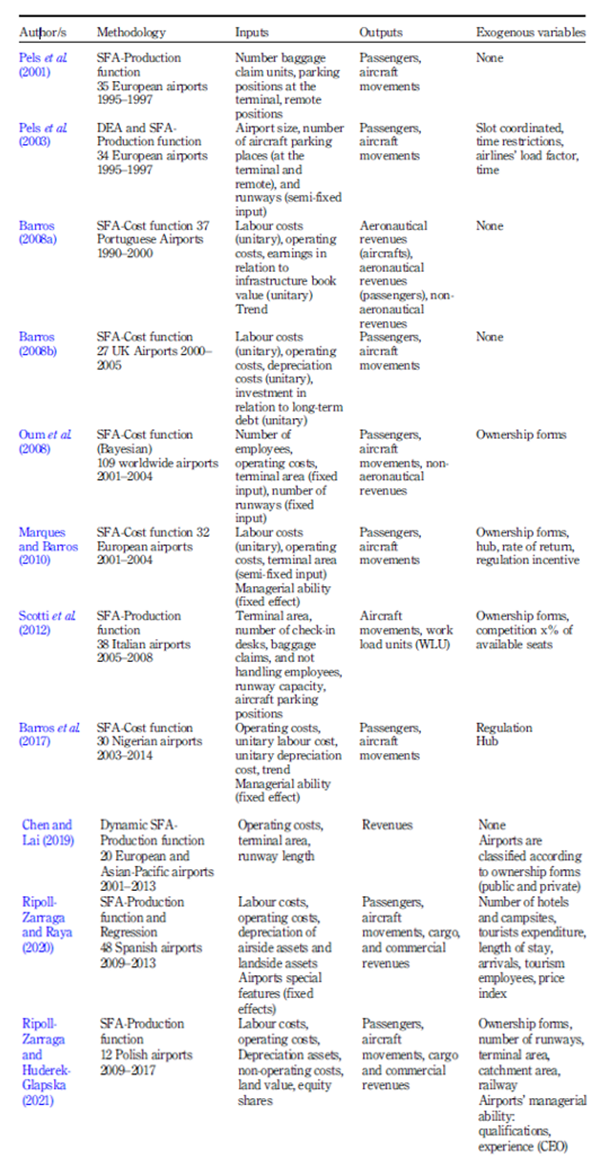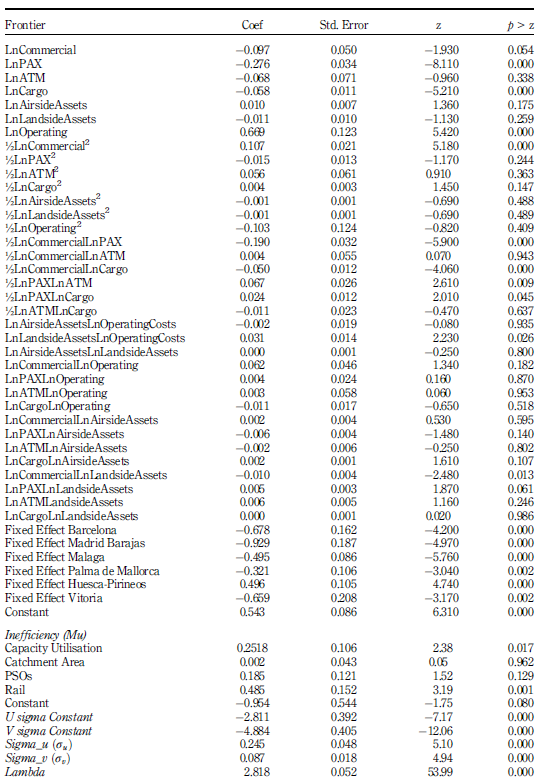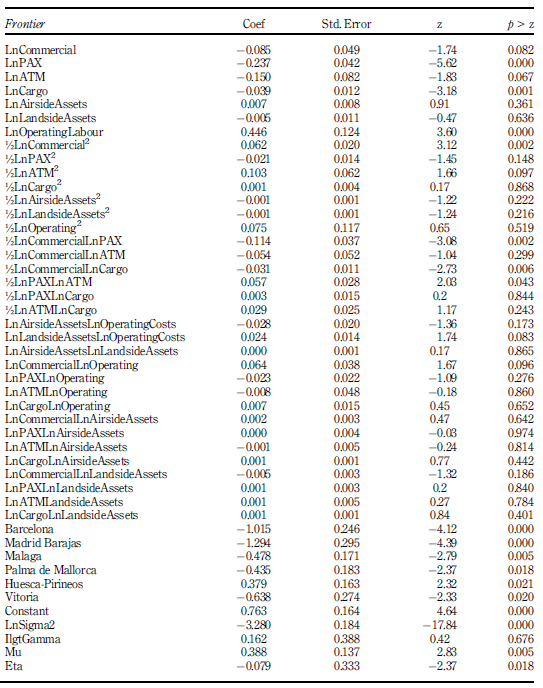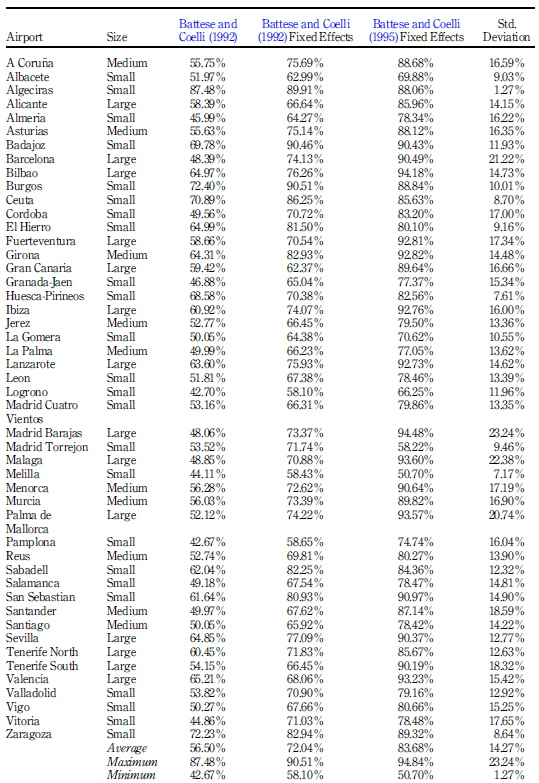Introduction
Government-owned airports are perceived as utilities which provide public services. Globalisation requires a rapid response market according to national and global needs and relies on a flexible decision-making process to make commercial decisions. The European Commission Flightpath established for 2050 (European Commission, 2011) requires connecting within 4 h door-to-door, as air connectivity contributes to economic development. Airports are essential players to the extent that the government becomes a facilitator (driver).
The Spanish airports are government-owned and managed through a public operator named (AENA) (https://www.aena.es). AENA's board of directors comprises politicians who may not have the industrial experience, skills and competencies necessary for efficiency (Ripoll-Zarraga and Huderek-Glapska, 2021). In addition, the board generally is renewed every four years with political elections; therefore, regulatory policies are also changed. Consequently, airport operators do not have flexibility, which is crucial to adapt to the changing global demand. Within this context, AENA controls the whole network with centralised management regarding pricing, investment and other decisions, including accounting policies. For example, prices are more related to the amount of traffic than the service's quality (Council of Ministers, 2011), which leads to questioning whether centralised management is better than a decentralised one (regional or municipal) in terms of efficiency. In addition, individual financial statements are not accessible or published, requested by industry stakeholders (Cambra de Comerç de Barcelona, 2010 ). In 2018, the national accounting and financial audit body Instituto de Contabilidad y Auditoría de Cuentas (ICAC) (https://www.icac.gob.es/en) fined 10.49 million euros in PriceWaterhouseCoopers (PwC). PwC breached its independence recurrently when auditing AENA's financial statements (BOE-A-2018-3940, resolution 13th of February 2018, published 20th of March 2018). The fine represented 5.25% of the audit fees collected. Citizens were not informed, and politicians did not question or request other audits from previous years. To date, there are no other data except from 2009 to 2014.
The European Court of Auditors (2014) determined an excess of wasted infrastructure in the past decade and a growing public deficit in Europe. For example, white elephants such as Ciudad Real Airport (which opened in 2008 forecast 2.5 million passengers and closed in 2012 after reaching 100,000 passengers in 2011) or fake high-speed aid requirements (European Commission, 2016). Except for airports located in the islands (Balearic and Canary Islands), which are public service obligation (PSO) routes and regional airports within an amenity distance of hubs and large airports, required to avoid congestion, the Spanish network contains too many regional airports under-used. Yet, the Spanish government is keen on keeping all airports operating. However, according to AENA, in 2013, out of 43, only 13 (large) airports were profitable, including four general aviation airports (Madrid Cuatro Vientos, Sabadell, Son Bonet and Madrid Torrejon) (GAs) and two heliports (Algeciras and Ceuta). The overall system is profitable (i.e. per the consolidated financial statements) per large airports cross-subsidising non-profitable airports. Cross-subsidisation is often used in transport, for example, to help regional development enhance economic prosperity. However, airport operators do not decide on commercial policies, reducing the attractiveness for airlines to operate in Spain (Comisión Nacional de los Mercados y la Competencia - National Commission of Markets and Competition - CNMC, for its Spanish acronym, 2014). Thus, cross-subsidisation cannot be a permanent solution for regional and secondary airports' sustainability. Airports are public investments. Unless operating efficiently, their fixed costs (overheads) are not absorbed. Inefficient public investments or mistaken public investment and managerial decisions - per not searching for reliable sources of inefficiency - increase the public deficit and taxpayers' contribution (i.e. 98.10% of gross government debt in 2017) (European Council, 2019).
Previous research in Spanish airports on efficiency relates to sources of inefficiency per the number of passengers (Martin et al., 2009) and cargo (Coto-Millán et al., 2016; Ripoll-Zarraga and Lozano, 2019). Few studies address other factors explaining efficiency, for example, outsourcing activities (Tovar and Martin-Cejas, 2009), low-cost carrier (LCC) (Coto-Millán et al., 2014) and airports' physical infrastructure (Lozano and Gutiérrez, 2009; Ripoll-Zarraga and Mar-Molinero, 2020). However, in the case of Spain, these are governmental decisions which may not relate to the regional needs in terms of air demand or connectivity and account for certain endogeneity. Overall, studies do not account for airports' environment and its specific characteristics influencing the number of passenger, cargo and aircraft movements. Indeed, references to the airports' context refer to the strict geographical location (for example, Martin and Roman, 2001, 2006; Tovar and Martin-Cejas, 2010 ). However, it does not explain the influence on traffic robustly. The lack of individual public data and AENA's strong centralised management not enhancing competition, along with a board of politicians rather than professionals, ends with a high number of regional airports without traffic, questioning the requirement of public investment for connectivity purposes, as per having alternative travel modes (high-speed train and motorways) and per increasing public deficit. Indeed, Ripoll-Zarraga (2018) and Ripoll-Zarraga and Mar-Molinero (2020) used Data Envelopment Analysis (DEA) and demonstrated that the AENA depreciation-published data does not correspond to the use of capacity in developing traffic. Consequently, the previous findings may be biased, i.e. unreliable for benchmarking purposes and managerial and policymakers recommendations.
The peculiarities of the Spanish airports' environment, where for example, the airport’s owner is the operator seems not to attract airlines to satisfy the current and future global demand. The situation requires a critical assessment of the Spanish airports' performance and reliable sources of efficiency. An efficiency benchmarked analysis is performed with stochastic frontier analysis (SFA) accounting for the airport environment determined by the Spanish government's investing decisions and geographical specifications. The SFA allows the inclusion of external non-managerial factors, no-controlled by the management and firm-fixed effects (Greene, 2003), to capture potential airports' features. Section 2 reviews the literature on air transport efficiency. Section 3 presents the model specification and data. The results are shown in Section 4, while a discussion and the conclusions are carried out in Sections 5 and 6, respectively.
2. Literature review
The evaluation of the efficiency of aviation service providers has extensive literature on airlines and airports, which compares, for example, private and public companies. However, these studies do not provide strong evidence that privatisation improves efficiency (Gallegos-Monteagudo, 1992). Privatisation is often encouraged to obtain financing resources when governments cannot provide further capital infrastructure (International Air Transport Association (IATA), 2018). Likewise, companies' performance studies have increased in relevance in the past 10 years (Salcedo, 2021). For a comprehensive view of airports' performance, see, for example, Bezerra and Gomes (2016). Airports efficiency studies generally use distance functional approaches to evaluate the relative technical efficiency of each decision-making unit. Within non-parametric methods, DEA, per a functional specification, is not required. Hence, it has become a popular technique (for a review of studies, see Emrouznejad and Yang, 2018). However, stochastic disturbance factors are not enclosed, i.e. efficiency estimates can be biased. Airports are multi-input output organisations. Therefore, efficiency analysis is adequate using stochastic frontier functions for estimation (Coelli and Perelman, 1999; Kumbhakar and Lovell, 2000), which are parametric methods. Efficiency analysis assumes that the inputs and outputs are decisional variables controlled by airports' management, but these may not be. Indeed, the SFA allows the inclusion of variables as external factors (not controlled). These are understood as external factors, usually as a proxy of airports' environment that affects airports' efficiencies. However, the management is unlikely to change, at least in the short-term such as terminals and runways (Pels et al., 2003; Oum et al., 2008). However, DEA does not search for sources of inefficiency, which is more commonly used in aviation, starting with Gillen and Lall (1997), compared to SFA. SFA models progress from homogenous assumptions (Pels et al., 2003; Kumbhakar et al., 2013) to unobserved heterogeneity (Barros, 2008a b; Barros et al., 2017) per airports behaving differently (i.e. residuals individual behaviour) and neglecting heterogeneity leads to inconsistent parameter estimates (Chesher, 1984). Within SFA, reasons to explain inefficiency often refer to ownership and governance forms (see Table 1).
Efficiency studies in Spain show that higher efficiencies correspond to more traffic (i.e. passengers). Again, only some studies seek sources of individual inefficiency beyond traffic. In Spain, this is essential as per airports operators' inability to decide inputs and outputs, prices, etc., since the Spanish government manages all government-owned airports (through AENA). Restrictions to operate freely and laws affect and determine the traffic since the inability to adjust production factors in the short term (e.g. Yu, 2010). The centralised management affects the flexibility of airports to operate, impairing the market attractiveness to airlines, thus, passengers. Recent studies confirm cargo specialisation improves overall system efficiency (Ripoll-Zarraga and Lozano, 2019). Ripoll-Zarraga and Raya (2020) analysed the Spanish airports differing between touristic versus non-touristic cities assuming that national and international visitors travel by air mode, which is unlikely for national tourists. Previous Spanish studies have yet to assess the data. Except for Ripoll-Zarraga (2018), Spanish airports' studies have not accounted for reliable depreciation proxies. These are extracted from AENA's financial statements without questioning or critically assessing the reliability of the data, for example, amortisation of non-current assets (Martin and Roman, 2001, 2006) and book value (for example, Murillo-Melchor, 1999; Coto-Millán et al., 2014, ( 2016). AENA has not published individual airports' financial statements from 2014, and notes are not disclosed regarding accounting policies such as methods of depreciation used (coefficients) or the number of employees. The use of the published data should be understood within the national framework, potentially implying the need for data harmonisation. The main concern is to find adequate measures of capital, hence the infrastructure. Rent expenses (Parker, 1999) are not an ideal proxy when infrastructure is not financed through leasing. Following Ripoll-Zarraga (2018), AENA depreciation data are disregarded. Instead, air transport depreciation standard coefficients are applied (International Accounting Standards (IAS) (https://www.iasplus.com/en/standards/ias) and International Financial Reporting Standards (IFRS) (https://www.ifrs.org/issued-standards/list-of-standards/).
The literature on air transport efficiency shows the lack of accounting for a specific framework. It looks like this is the first time to use contextual, geographical specifications and airport features, beyond the strict airports' location, specifically within the Spanish framework.
3. Method
3.1 Model
Following Battese and Coelli (1992, 1995), a time-varying model is applied within the context of SFA. The model (1995) allows the inclusion of environmental variables understood as not controlled by the management, at least in the short term. The advantage of SFA compared to DEA is that efficiency can change over time and allows alternative distribution assumptions of the inefficiency term. Additionally, by transforming the production distance function into a translog functional form, the model can be estimated as a regression model with a one- and two-degree level of iteration between the variables enclosed in the production function (controlled by the management).
The translog form of the stochastic distance function I n D it (X,Y) assuming m outputs and k inputs and choosing arbitrary the ϗ-th input for normalisation purposes follows:
where the asterisk indicates the respective input normalised
The input normalisation is necessary to impose the homogeneity constraints,
These are equality constraints regarding unknown parameters, and they are invariant. The second-order parameters satisfy:
The error contains a random error (v it ) with non-negative truncated normal distribution with zero mean and constant variance vi ∼N+ (0; σ 2 Þ ): The inefficiency term (u it ) has a non-zero mean and constant variance ui ∼N+(μ; σ2 u). The variance parameters reflect what extent the variables used in the trans log explain the dependent variable and the overall inefficiency. The sigma squared σ2 = σ2 u + σ2 v (5) is used to analyse the normal distribution of the random variables (v it ) independent of the inefficiency (u it ) and identically distributed v it ∼N (0; σ 2 v ). The noise variance (σ2 p) represents the variability of the error. The model explanatory power due to technical inefficiencies is measured through the lambda λ = σu/σv (6).
Several models were tested for panel data context, time-varying and invariant inefficiencies, and different distributions of the inefficiency term (Battese and Coelli, 1988, 1992, 1995; Kumbhakar, 1990), including testing runways as semifixed input (Pels et al., 2003; Yu, 2010), which implies a different specification (For multi-output frontier models, see Zhang and Garvey (2008)). The low variability of the data implied convergence issues for some SFA models. After validating the model, two distributions for the time-varying inefficiency term are considered: Battese and Coelli (1992) assume that the inefficiency is caused overall by managerial decisions. Battese and Coelli (1995) enclose environmental variables (z it ), where
(7), understood as the airports' economic environment differing between inefficiency caused by managerial decisions (production function) compared to the inefficiency caused by external factors and affecting the overall inefficiency. Including the environmental variables
within the translog function, avoids bias usually following the second stages (Wang and Schmidt, 2001). Following Greene (2003), fixed effects account for singularities not initially observed in the external factors imposing heterogeneity across the sample but are not necessarily present in all airports, i.e. these are time-invariant characteristics of the variable.
The model also allowed the detection of airports with singularities in traffic, regulation and operational activity. After removing them from the initial sample, no significant differences were reported. The final data refers to 48 airports, i.e. excluding Son Bonet for missing information from 2009 to 2013 (239 observations): Algeciras was under construction in 2009, and functional conditions from July 2010 to 2014 were disregarded per changes in accounting policies, which may bias the data previously published. Unfortunately, there are no further data published. For insights regarding SFA and DEA, specifically the Spanish airports, see Ripoll-Zarraga (2018), who widely discusses the lack of transparency of AENA. For example, there are few notes to the annual reports, but without information regarding the number, type of employees or other relevant indicators.
The sample contains 14 airports with more than 3.5 million passengers per year that are also profitable, i.e. according to AENA's reported EBITDA (earnings before interest tax depreciation and amortisation).
3.2 Variables
According to the data available, extracted from AENA's annual reports - except for the depreciation of assets - and literature review, three inputs and four outputs are modelled. On the input side are labour costs, other operating costs and depreciation of airside and landside assets (Ashford et al., 1996). The labour costs are the salaries accrued, social security and other employees' costs. The operating expenses are the rest of incurred costs (i.e. excluding depreciation and staff) required for aeronautical and commercial activities, which may bear interest, is unknown. Airside assets account for aeronautical terminals, aprons, runways, airfields (taxi and access to runways), control towers and beacon systems. The landside assets are cargo and passenger terminals, emergency and parking buildings, work and maintenance buildings, and recycling systems. Finally, the outputs are the annual number of passengers, air traffic movements (ATM), tonnes of cargo and commercial revenues per year.
Table 2 shows the statistics, including AENA's depreciation, for informative purposes. The currency data are deflated by the Spanish gross domestic product (base 2010). The respective geometric mean standardises the variables. Zero values were substituted by unitary values to avoid removing observations from the sample.
After testing several exogenous variables, including airports' charges (AENA's price policies), the environmental factors capturing features of the airports' environment follow capacity utilisation, catchment area, PSO routes and railway access into the airport. Table 3 reports their descriptive statistics. Capacity utilisation is the ability to use airports' infrastructure according to air traffic control restrictions: slot coordinated (1), summer coordinated (2), schedules provided (3) and not coordinated (4), which includes military and general aviation operations. Airports coordinated (1 and 2) are usually airports with a constraint capacity, which does not satisfy the current and potential demands (Asociación Española para la Coordinación y Facilitación de Franjas Horarias (AECFA), 2014) (www.slotcoordination.es/es/slot/inicio). Airports not coordinated or with schedules provided are not capacity constrained. Slot-coordinated airports are Alicante, Barcelona, Bilbao, Madrid, Malaga and Valencia. In the Canary Islands, Gran Canaria, Fuerteventura, Lanzarote and Tenerife South and the Balearic Islands, Palma de Mallorca. Airports coordinated during summer are Ibiza and Menorca. The catchment area is the geographical area from which the location attracts the population to use an airport, defined as the number of airports within 150 km. For example, Vitoria's catchment area contains five airports. PSOs are intra-insular routes in the Balearic and Canary Islands and Almeria to Sevilla (April 2009), ensuring connectivity. Five airports have a railway within the airport (Alicante, Barcelona, Madrid, Malaga and Jerez).
4. Results´
4.1 Stochastic frontier analysis
The model shows relevant and high explanatory power (lambda >1) and a low level of noise (σu >σv) (see Table 4). The individual variables have the expected signs: the outputs increase efficiency (reduce the distance to the frontier) and the inputs decrease efficiency (increase the distance). Passengers contribute the most to efficiency (−27.65%) and cargo the least (−5.80%). There are only two cargo-oriented airports (Vitoria and Zaragoza). Commercial revenues are a relevant source of income. However, these relate to the privatisation process (Humphreys, 1999). Depreciation is not significant, highlighting the inadequacy of infrastructure for aeronautical activities (underused) or cargo (+0.000). Instead, operating costs are relevant (66.94%). Barcelona, Madrid Barajas, Malaga and Palma de Mallorca show special features increasing efficiency, and Huesca-Pirineos, which is small, reduces it (+49.59%). These results are consistent with the literature, as large airports are the most efficient. However, large airports (Barcelona and Madrid) show a higher impact than others with demand peaks (Malaga and Palma de Mallorca). The cargo-oriented airport (Vitoria) contributes to efficiency at the same level as the second-largest airport (Barcelona). Regarding the iteration effects, more passengers increase efficiency by 19% for 1 million euros spent on commercial activities (−19.00%). This trade-off is the opposite for cargo and aircraft movements, increasing inefficiency (+2.44% and +6.69%). These results confirm that cargo - with the independence of the number of passengers and aircraft movements - contributes to increasing efficiency (−5.80% and −6.77%). These results confirm previous findings as cargo becoming essential in aviation (Ripoll-Zarraga and Lozano, 2019). The iteration depreciation of landside assets-commercial revenues is low (−0.98%), highlighting the requirement to use passengers' terminal areas for commercial exploitation. The results are consistent for the time-varying model (Battese and Coelli, 1992), with a slight trade-off between ATM (−15.03%) and operating costs (+44.58%). The no existence of inefficiency (39%) is rejected to enclose the external factors to avoid bias (Hattori, 2002) (see Appendix1). Both models report the largest airports reducing inefficiency the most.
The inverse of the sum of the first-degree coefficients of outputs with the sign changed allows the estimation of the returns to scale (Coelli and Perelman, 1999). Accordingly, most Spanish airports operate under increasing returns to scale from 2009 to 2013, i.e.
. Polish airports operate under constant returns to scale, i.e. inputs elasticities - output trans log distance function - (Ripoll-Zarraga and Huderek-Glapska, 2021). Polish airports are government-owned but decentralised managed. Centralised management seems to affect how airports operate by increasing traffic through political decisions rather than industry and regional need, and with more impact on large airports, such as Barcelona and Madrid, versus the small airports with bare traffic, i.e. passengers - overcapacity.
The environmental variables show significant capacity utilisation and rail. Airports with less controlled traffic and less restricted to specific slots are more inefficient (25.18%). Most of the traffic is concentrated in large airports or with demand peaks, which are coordinated. The rest of the airports suffer from a relevant lack of traffic, i.e. infrastructure under-used. Airports with train facilities within the airport increase the overall inefficiency of the network (48.50%). Indeed, four out of five airports with train facilities are large, reducing regional airports' traffic. The PSOs do not affect efficiency. The government ensures that airlines operate these routes for connectivity purposes with no passengers. The catchment area is irrelevant, i.e. unable to implement commercial policies, and crowded geographical locations do not have congested airports (e.g. Vitoria cargo specialised). Small airports are more technically inefficient on average, confirming previous findings, i.e. accounting for all inputs and outputs (e.g. Murillo-Melchor, 1999; Salazar de la Cruz, 1999; Martin and Roman, 2001, 2006; Coto-Millán et al., 2007, ( 2014). However, the results show the reasons behind inefficiency beyond the operational variables. Tapiador et al. (2008 ) accounted for contextual variables (geographical location and inter-modality: motorway, road and rail). The relatively short distances encourage travellers to use alternative modes unless LCCs provide a service.
Table 5 reports the average technical efficiency per airport for time-varying efficiency without and with environmental variables (Battese and Coelli, 1992, 1995) and fixed effects (Greene, 2003), which improve the average efficiency per airport. In addition, the model shows higher explanatory power per isolating unobserved special features of airports (for example, Barcelona, Madrid Barajas, Malaga and Palma de Mallorca).
4.2 Catchment areas
Table 6 shows the geographical location of catchment areas, size, population, density and the EBITDA (i.e. according to and published by AENA). The airport efficiencies correspond to Battese and Coelli (1995), i.e. higher likelihood and lower noise. The northern area contains small, inefficient airports, with more than one in their catchment area. Melilla (50.70%), Madrid Torrejon (58.22%), Logrono (66.25%) and Albatece (69.88%) are consistently the most inefficient and no other airports in the catchment area. These airports are small and not specialised. Instead, Córdoba (83.20%) became a general aviation airport, and Algeciras (88.06%) a heliport. In this regard, Ripoll-Zarraga and Mar-Molinero (2020) warn that the diversification of airport activities improves efficiency, regardless of their proximity to other airports and the size of each one (Coto-Millán et al., 2016). For example, Zaragoza (89.32%) and Vitoria (78.48%) are cargo-oriented airports, but Vitoria is significantly less efficient and smaller than Zaragoza (1). These geographical areas are not congested, and airports become cost-inefficient (Martin et al., 2011).
Table 6 Catchment areas and technical efficiency (2009-2013)
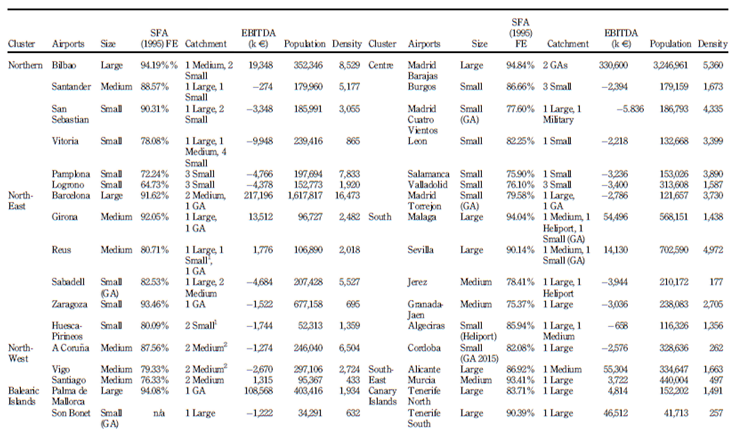
Note(s): 1 Huesca-Pirineos and Reus have in the same catchment area Lleida that is a small airport managed by Aeroports de Catalunya. Since January 2014, Huesca-Pirineos has not scheduled services. 2 Vigo is located 158 km from A Coruña
Note that in some cases, efficiency looks noncorrelating with profitability. EBITDA is a proxy of economic profitability that does not reflect the inputs to generate traffic. Following the accruals and matching conventions to ensure the correlation between expenses and revenues, hence profitability, depreciation methods must be accurate. The international regulatory framework (IFRS) requires disclosing the depreciation method. However, AENA does not. This bias may happen in other countries and is accepted if individual data and disclosures are published. Closure recommendations are suggested subject to airports not specialising, and airports managers are not granted decision-making power or managerial decentralisation in regional authorities (see Appendix 2). Passengers closer to an airport will use that airport (IATA, 2013). When having more options, i.e. located in overlapping catchment areas, passengers may switch airport preferences. Potential travellers may identify two airports as substitutes depending on the different aspects beyond product differentiation related to airline competition, but others, such as accessibility. It is evidenced that passengers' preferences, for example, regarding the purpose of the journey (business, leisure or visiting relatives), travel distance and flight destination, etc., may also affect passengers' choices, but this is beyond the scope of this paper.
Table A2 Catchment areas: transfer of traffic (2009-2013)
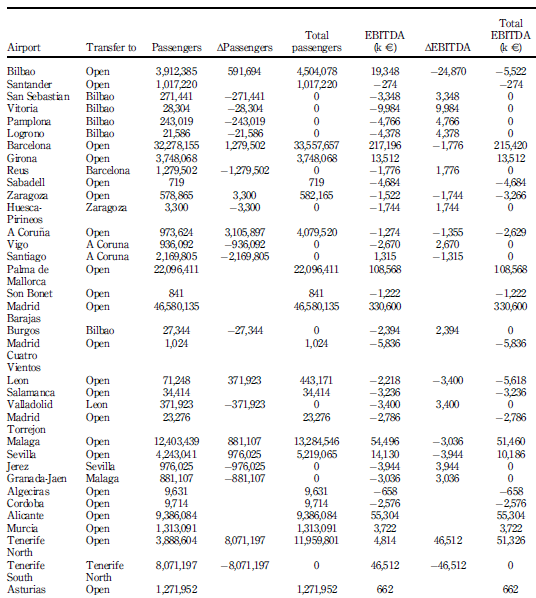
Note(s): Large airports are located in cities with higher density, thus, with potential higher demand. The closure suggestions are for small airports, not cargo-specialised and are technically inefficient. The airports that remain open even having low-efficiency scores or losses are Cordoba (GA) and Salamanca (for connectivity
purposes). The more traffic these regional airports have, the more technically efficient and profitable. In the end, the whole network will win using infrastructure and profitability
5. Discussion
5.1 Theoretical implications
Previous studies using SFA do not consider airports directly influenced by political decisions like public investments. These are decisions that affect airports in terms of catchment area and rail infrastructure, public service requirements (PSO) or use of airport capacity.
5.2 Policy and managerial implications
AENA's Board of Directors comprises politicians who may not have the necessary professional skills and industry experience to invest with money paid by taxpayers. Likewise, regional airports show excessive investment spending, considering their traffic is meagre. Most airports do not use infrastructure for aeronautical purposes highlighting the public utility nature of the Spanish airports: social welfare (connectivity purposes, public employment) overrides industry needs. The Spanish government seems committed to keeping all the airports open, not granting individual management even if they are lost-makers (Ripoll-Zarraga and Mar-Molinero, 2020) and increasing public deficit. Managerial decisions must address regions' needs and airports' available resources, but at the same time, airports should have enough independence to compete for airlines and passengers. The (long-term) network sustainability requires competition between large airports, i.e. to increase traffic; to attract airlines. The excessive number of airports within amenity distances promotes specific airports as the origin (or destination) to the detriment of others. Smaller airports become more efficient with specialisation (Ripoll-Zarraga et al., 2023). Diversification will help small airports operate with large airports in the same catchment area. Airports require specialising rather than becoming efficient overall, i.e. maximising passengers, movements or cargo levels to increase efficiency. Small airports can be used as secondary airports to support large airports to avoid congestion and unnecessary further investments in increasing capacity. There is a discrepancy between AENA's profitability and technical inefficiencies. AENA's published data seem not to be the true and fair view of the Spanish airports' performance (Financial Reporting Council, 2014). The Spanish airport charges do not have an apparent relationship with the quality of the service provided (CNMC, 2014). Airport managers should decide the rates and quality of services, preventing secondary airports from burdening the system in the long run, for example, by reducing cross-subsidies. Unless traffic increases, regional airports are an idle resource and increase the public deficit.
The European Commission establishes a common framework to regulate essential features of charges paid by airlines to airports considering that the market for passengers and cargo services is competitive. Airports require aligning competitive prices with the service provided. The quality of airport operations and services is perceived as a relevant attractor for airlines in a similar range as slot availability (Bilotkach and Bush, 2020). The infrastructure is invested. Hence minimising costs is difficult to meet. The Spanish airports require implementing strategies to reduce fixed costs and financing costs from borrowings to finance the investments. Competition drives prices down. Thus, airlines will pass the increment of charges (or decrement) to passengers or freight customers (European Commission, 2019) (2). Public investment may enhance long-term economic growth (e.g. education, healthcare and technology) and the well-being of citizens - specifically - in developing regions (Ayvar-Campos et al., 2019). However, in the end, adequate public management of public resources is required to avoid transferring the politicians' inefficiency in decision-making to cost taxpayers.
5.3 Limitations and future research agenda
The most important limitation is the lack of data. The only published data are from 2009 to 2014. There are no notes to the annual report individually per airport. There is evidence of the lack of consistency and adequacy of depreciation methods and aeronautical activities. With this regard, AENA's depreciation was disregarded. Future research will consist of comparing Spanish airports with Norway. Both countries have an airport system managed by a public operator. However, Norway has a decentralised management, and most regional airports are required for connectivity due to extreme winter conditions. To question if the data regarding investments made and profitability indicators, such as revenues, are a true and fair view of the Spanish airports or amended to protect political interests. The inclusion of fixed effects reveals unobserved heterogeneity within the data. Airports' structural characteristics, including their geographical environment, must be assessed. Endogeneity issues are inherent in SFA with distance functions (Amsler et al., 2016). Cost functions should be used to overcome this issue. However, it will require price information and output prices are externally decided by AENA rather than airports' operators, which could restrict the benchmarked analysis and bias the results. Finally, updated data are required.
6. Conclusions
In this study, an SFA is used to estimate the technical efficiency of the Spanish airports and sources of inefficiency accounting for exogenous factors and fixed effects. Passengers and aircraft movements are equally relevant to reduce airports' inefficiency and commercial revenues only with the presence of passengers. Cargo has a low impact on efficiency except for airports that are logistic centres such as Zaragoza. Infrastructure invested in remote areas is not always costly and technically inefficient. Governments invest for connectivity purposes and regional development. However, in Spain, too many airports in the same regional areas are underused, and demand is low per exogenously affected by the price or quality incentives to travel by air. These areas have good inter-modal connectivity by railway and roads. Indeed, the depreciation of airside and landside assets was not significant. The results show small airports - if specialised - contribute to the financial aspect of the system to the extent that other airports specialise in alternative activities within the same catchment area. However, the Spanish Government treats airports as public utilities for social welfare purposes (public employment). Politician interests are prioritised rather than the factual industry needs (Ripoll-Zarraga and Huderek-Glapska, 2021).
The Spanish network is costly to run (World Finance, 2016). The Spanish airports have engaged in commercial activities with their aeronautical mission. Despite being government-owned, AENA does not receive public subsidies. AENA was privatised partially in February 2015 (49%). Nevertheless, there is a need for the Spanish airport system's financial sustainability. According to IAS, based on the matching convention, the expected usage of infrastructure materialised as a loss of value across the years (i.e. depreciation) must be aligned with the earnings from aeronautical revenues. Most of the Spanish airports are currently suffering from over-capacity. Spanish aviation must become a competitive domestic market, with individual management granted the power to negotiate with airlines and invest in commercial policies to differentiate between them. AENA's price system does not enhance product differentiation, i.e. according to the service provided by the airports, which must change accordingly. Nine of 10 international airports cooperate with local governments, tourist authorities and chambers of commerce as part of their route development (Bilotkach and Bush, 2020). However, it is not the case for Spain due to the strong-centralised management and lack of competition. The competition will enhance the use of infrastructure concerning the current traffic. The Spanish airport network requires flexibility and decisions according to the needs of specific areas from industrial and social perspectives. LCCs are interested in operating, not only if the market is attractive but if the regulatory framework does not become an entrance barrier. Decisions directly affecting air traffic are unable without competition, thus, differentiation. Large and medium airports are highly efficient. More than one airport serving the same area within an amenity distance forces cross-subsidisation. Although this may be necessary for regional development, competition could reduce the pressure on large airports to generate enough funding for network sustainability and, at the same time, improve network efficiency. Small airports could become attractive to airlines and become LCC bases if the market is granted freedom to compete.
Notes
1. Bilbao, Burgos, Logrono, Pamplona, San Sebastián and Santander. Zaragoza has only one airport in the catchment area and is passengers-oriented (Huesca-Pirineos).
2. The national transposition measures applied go from the 15th of March 2011 until March 2019. Although this study is from 2009 to 2013, the EC directives highlight the lack of compliance and the Spanish airports' singularities.













